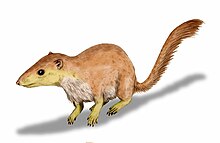| Purgatorius | |
|---|---|

| |
| Life restoration of P. unio | |
| Scientific classification | |
| Domain: | Eukaryota |
| Kingdom: | Animalia |
| Phylum: | Chordata |
| Class: | Mammalia |
| Order: | Plesiadapiformes |
| Family: | †Purgatoriidae |
| Genus: | †Purgatorius Valen & Sloan, 1965 |
| Type species | |
| †Purgatorius unio Valen & Sloan, 1965
| |
| Species | |
Purgatorius is a genus of seven extinct eutherian species typically believed to be the earliest example of a primate or protoprimate, a primatomorph precursor to the Plesiadapiformes, dating to as old as 66 million years ago.[3][4] The first remains (P. unio and P. ceratops) were reported in 1965,[5] from what is now eastern Montana's Tullock Formation (early Paleocene, Puercan), specifically at Purgatory Hill (hence the animal's name) in deposits believed to be about 63 million years old, and at Harbicht Hill in the lower Paleocene section of the Hell Creek Formation. Both locations are in McCone County, Montana.
They have also been found in the Ravenscrag Formation and widely discovered in the early Paleocene Bug Creek Group, along with leptictids.[6] These deposits were once thought to be late Cretaceous, but it is now clear that they are Paleocene channels with time-averaged fossil assemblages. It is thought to have been rat-sized (6 in (15 cm) long and 1.3 ounces (about 37 grams)) and a diurnal insectivore, which burrowed through small holes in the ground. In life, it would have resembled a squirrel or a tree shrew (most likely the latter, given that tree shrews are one of the closest living relatives of primates, and Purgatorius is considered to be the progenitor to primates). The oldest remains of Purgatorius date back to ~65.921 mya, or between 105 thousand to 139 thousand years after the K-Pg boundary.[4][7]
- ^ Wilson Mantilla, G. P.; Chester, S. G. B.; Clemens, W. A.; Moore, J. R.; Sprain, C. J.; Hovatter, B. T.; Mitchell, W. S.; Mans, W. W.; Mundil, R.; Renne, P. R. (2021). "Earliest Palaeocene purgatoriids and the initial radiation of stem primates". Royal Society Open Science. 8 (2): 210050. Bibcode:2021RSOS....810050W. doi:10.1098/rsos.210050. PMC 8074693. PMID 33972886.
- ^ Scott, Craig S.; Fox, Richard C.; Redman, Cory M. (2016). "A new species of the basal plesiadapiform Purgatorius (Mammalia, Primates) from the early Paleocene Ravenscrag Formation, Cypress Hills, southwest Saskatchewan, Canada: further taxonomic and dietary diversity in the earliest primates". Canadian Journal of Earth Sciences. 53 (4): 343–354. Bibcode:2016CaJES..53..343S. doi:10.1139/cjes-2015-0238. hdl:1807/71784.
- ^ O'Leary, M. A.; et al. (2013). "The placental mammal ancestor and the post–K-Pg radiation of placentals". Science. 339 (6120): 662–667. Bibcode:2013Sci...339..662O. doi:10.1126/science.1229237. hdl:11336/7302. PMID 23393258. S2CID 206544776.
- ^ a b Wilson Mantilla, Gregory P.; Chester, Stephen G. B.; Clemens, William A.; Moore, Jason R.; Sprain, Courtney J.; Hovatter, Brody T.; Mitchell, William S.; Mans, Wade W.; Mundil, Roland; Renne, Paul R. (2021). "Earliest Palaeocene purgatoriids and the initial radiation of stem primates". Royal Society Open Science. 8 (2): 210050. Bibcode:2021RSOS....810050W. doi:10.1098/rsos.210050. PMC 8074693. PMID 33972886.
- ^ Van Valen, L.; Sloan, R. (1965). "The earliest primates". Science. 150 (3697): 743–745. Bibcode:1965Sci...150..743V. doi:10.1126/science.150.3697.743. PMID 5891702. S2CID 22055105.
- ^ Lillegraven, Kielan-Jaworowska & Clemens 1979
- ^ Renne, Paul R.; Deino, Alan L.; Hilgen, Frederik J.; Kuiper, Klaudia F.; Mark, Darren F.; Mitchell, William S.; Morgan, Leah E.; Mundil, Roland; Smit, Jan (2013-02-08). "Time Scales of Critical Events Around the Cretaceous-Paleogene Boundary". Science. 339 (6120): 684–687. Bibcode:2013Sci...339..684R. doi:10.1126/science.1230492. ISSN 0036-8075. PMID 23393261. S2CID 6112274.